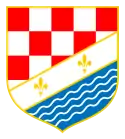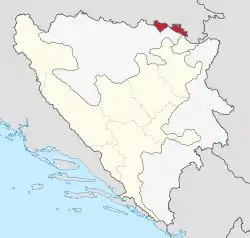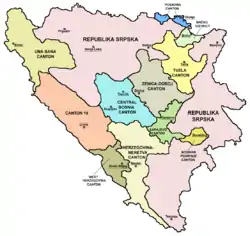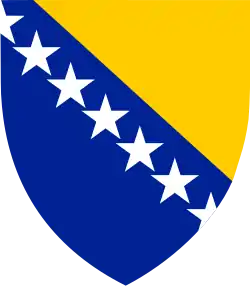Posavina Canton
The Posavina Canton (Croatian: Županija Posavska, Bosnian and Serbian: Posavski kanton/Посавски кантон) is an exclave, and one of ten cantons of the Federation of Bosnia and Herzegovina in Bosnia and Herzegovina. It is the smallest canton with an area of only 325 km². Its capital is Orašje.
Posavina Canton Posavski kantonŽupanija Posavska | |
|---|---|
 Flag
 Coat of arms
| |
 | |
| Status | Canton of the Federation of Bosnia and Herzegovina |
| Capital and largest city | Orašje |
| Official languages | Croatian and Bosnian |
| Ethnic groups (2013[1]) | 77.32% Croats 19.00% Bosniaks 1.91% Serbs 1.77% others |
| Demonym(s) | Posavinian |
| Government | Parliamentary system |
| Đuro Topić (HDZ BiH) | |
| Legislature | Assembly of the Posavina Canton |
| Canton of the Federation of Bosnia and Herzegovina | |
• Establishment | 12 June 1996 |
| Area | |
• Total | 325 km2 (125 sq mi) |
| Population | |
• 2013 census | 43,453 |
• Density | 147.97/km2 (383.2/sq mi) |
| GDP (nominal) | 2019 estimate |
• Total | BAM 218.404 million |
• Per capita | BAM 4920.7 |
| Currency | BAM |
| Time zone | UTC+1 (CET) |
| UTC+2 (CEST) | |
| Date format | dd-mm-yyy |
| Driving side | right |

Municipalities
The canton is split into the municipalities of Domaljevac-Šamac, Odžak, and Orašje.
Politics
The cantonal assembly is composed of:
- Croatian Democratic Union, HSS BiH, HKDU BIH – 11
- Croatian Democratic Union 1990 – 3
- Party of Democratic Action – 2
- Posavina Party – 2
- Social Democratic Party of Bosnia and Herzegovina – 1
- Union for a Better Future of BiH – 1
- Movement of Democratic Action – 1
Geography
The canton lies near the border with Croatia and near the river Sava which forms a natural border between Bosnia and Herzegovina and Croatia. Odžak and Orašje-Domaljevac form two exclaves of the Federation of Bosnia and Herzegovina.
Posavina is a region which includes other parts of Bosnia and Herzegovina and parts of Croatia. Because of that, this canton is sometimes called Bosanska Posavina (Bosnian Posavina) and is the only part of northern Bosnia near the border with Croatia that lies in the Federation. The rest of northern Bosnia near the river Sava and near the border is the Brčko District and the Republika Srpska. The Brčko district divides Republika Srpska into 2 parts.
The Posavina canton's position near the Sava river makes it a good place for agriculture because it is a flat lowland and there are no mountains in the area. It is like this in the entire northern border with Croatia, with a great deal of farming and agriculture. The river Sava is a river that flows through Slovenia, Croatia, Bosnia and Herzegovina and Serbia. In Bosnia and Herzegovina it flows through the northern border and makes a natural border between Bosnia and Herzegovina and Croatia.
Posavina means literally along Sava in the Bosnian language. The river Sava is the largest navigable river in Bosnia and Herzegovina. Much of the food in both Bosnia and Herzegovina and Croatia comes from this region, not only Bosnian Posavina but the rest of the fertile fields along the river Sava.
Demographics
2013 Census
| Municipality | Nationality | Total | |||||
|---|---|---|---|---|---|---|---|
Bosniaks |
% |
Croats |
% |
Serbs |
% | ||
| Odžak | 6,220 | 33.04 | 11,621 | 61.74 | 582 | 3.09 | 18,821 |
| Orašje | 2,015 | 10.14 | 17,345 | 87.33 | 157 | 0.79 | 19,861 |
| Domaljevac-Šamac | 17 | 0.35 | 4,634 | 97.12 | 92 | 1.92 | 4,771 |
| Canton | 8,252 | 18.99 | 33,600 | 77.32 | 831 | 1.91 | 43,453 |
Page text.[2]
| Municipality | Nationality | Total | |||||||
|---|---|---|---|---|---|---|---|---|---|
Croats |
% |
Serbs |
% |
Bosniaks |
% |
Other |
% | ||
| Odžak | 16,338 | 54.36 | 5,667 | 18.85 | 6,220 | 20.69 | 1,831 | 6.09 | 30,056 |
| Orašje | 21,308 | 75.12 | 4,235 | 14.93 | 1,893 | 6.67 | 931 | 3.28 | 28,367 |
| Domaljevac-Šamac | 4,598 | 98.02 | 26 | 0.55 | 7 | 0.15 | 60 | 1.28 | 4,691 |
| Canton | 42,224 | 66.90 | 9,928 | 15.73 | 8,113 | 12.85 | 2,822 | 4.47 | 63,114 |
Sport
HNK Orašje, the local football club from Orašje that won the Bosnia and Herzegovina Football Cup in the 2005–06 season.
References
| Wikivoyage has a travel guide for Posavina. |
- Sarajevo, juni 2016. CENZUS OF POPULATION, HOUSEHOLDS AND DWELLINGS IN BOSNIA AND HERZEGOVINA, 2013 FINAL RESULTS (PDF). BHAS. Retrieved 30 June 2016.
- Link text, additional text.
